| « Chicago Urban League: Celebrating Black History Through Cinema | Untitled Hosts "Unbustled," A Burlesque Competition » |
Art Mon Feb 03 2014
Review: Post-Street Art in Two Exhibits at Maxwell Colette Gallery
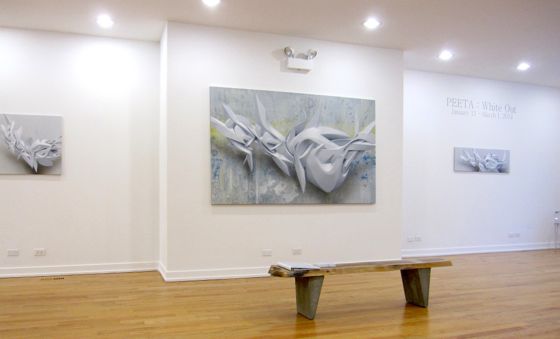 The classically modern Maxwell Colette Gallery, open since 2010, is on an undistinguished strip of Ashland Avenue in Noble Square, but don't be deterred by the surroundings. The current exhibit of the work of two artists--one local, one internationally known--is artfully displayed in the two-level gallery and warrants a close look. The art is considered "post-street art" by gallery director Oliver Hild, whose gallery specializes in that genre.
The classically modern Maxwell Colette Gallery, open since 2010, is on an undistinguished strip of Ashland Avenue in Noble Square, but don't be deterred by the surroundings. The current exhibit of the work of two artists--one local, one internationally known--is artfully displayed in the two-level gallery and warrants a close look. The art is considered "post-street art" by gallery director Oliver Hild, whose gallery specializes in that genre.
The two exhibits provide a vibrant contrast in the evolution of street art.
White Out is the exhibit by Peeta, an Italian graffiti artist. His elegant mixed media pieces are created by taking the traditional letterforms that make up his name and bending, twisting, folding and styling them with shape and volume. His backgrounds suggest graffiti spraying, while the imagery is crystalline white and shadow.
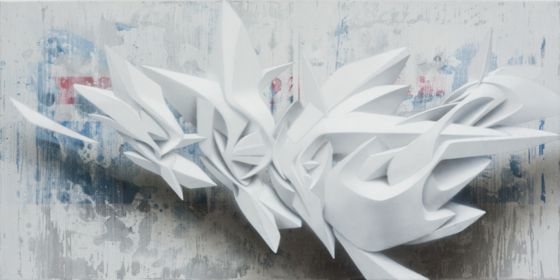
Peeta says that the paintings in White Out are an "attempt to render the most deceptive condition that snow can cause; in which visibility and contrast are so severely reduced that no reference point remains, and the individual experiences a distorted orientation." Far from cold, these new paintings instead have a "bright, sparkling, total whiteness." Peeta, also known as Manuel Di Rita, lives in Venice; he has been a graffiti artist since 1993.
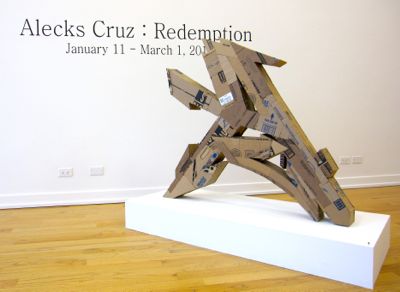 In Redemption, Chicago sculptor Alecks Cruz forms sculptures suggesting graffiti tags from corrugated containers, carefully cut to retain rough seams and preserve the product branding from the original containers. His six sculptures, three to four feet tall, are meant to be viewed from all sides. He adds no color or decoration, but lets the printing and branding color form marquetry patterns.
In Redemption, Chicago sculptor Alecks Cruz forms sculptures suggesting graffiti tags from corrugated containers, carefully cut to retain rough seams and preserve the product branding from the original containers. His six sculptures, three to four feet tall, are meant to be viewed from all sides. He adds no color or decoration, but lets the printing and branding color form marquetry patterns.
Cruz started with a spray can, as most graffiti artists do, but now focuses on letterforms that retain the stylistic essence of street art. Cruz is a self-taught artist and graphic designer who lives in Berwyn.
All the paintings and sculpture shown are for sale.
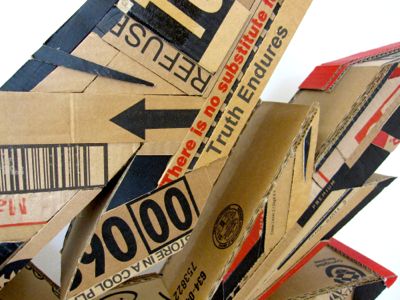 What is "post-street art?," I asked Hild, whose background is in analog photography and who now buys and sells art in his gallery and online. "Post-street art is street art or graffiti that is no longer underground. It's now commercial and collectible." The tipping point that brought street art into the mainstream, Hild feels, came through two events.
What is "post-street art?," I asked Hild, whose background is in analog photography and who now buys and sells art in his gallery and online. "Post-street art is street art or graffiti that is no longer underground. It's now commercial and collectible." The tipping point that brought street art into the mainstream, Hild feels, came through two events.
In 2008 Shepard Fairey, a street artist, created posters for Barack Obama's campaign; the "Hope" portrait version was adopted by the campaign and became its iconic symbol. That portrait is now part of the permanent collection at the National Portrait Gallery in Washington.
The second tipping point was the 2010 documentary, Exit Through the Gift Shop, that explores the commercialization of underground art. An eccentric French filmmaker tries to make a film about the elusive Banksy, the graffiti artist with a global reputation. The film, which won an Academy Award nomination and several regional awards, is actually made by Banksy who turns the camera back on the amateur filmmaker. Peter Travers said in his Rolling Stone review "The wild ride of a film...sees the art world as a circus, taking in the nut jobs and the celebrated likes of Shepard Fairey, Neckface, Swoon and Banksy himself."
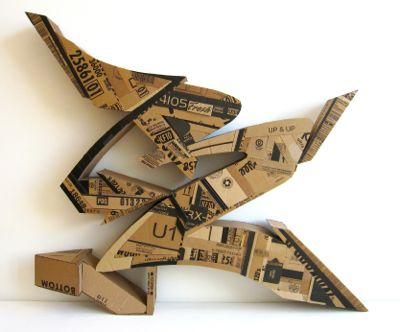
Today, the work of Banksy, Cause, Invader, Basquiat, Keith Haring, and other street artists, is shown in galleries, and Hild offers many of them for sale online. Banksy created a monthlong show on the streets of New York last October. Better Out Than In featured a new piece of art or an art event in an new location each day.
Of course, Chicago has a long and vibrant history of wall art and mural art in many neighborhoods. Much of it was originally underground art and tagging by graffiti artists, but now it is often fostered and supported by community organizations, as recent Gapers Block stories described.
The Chicago Cultural Center presented an exhibit titled Paint Paste Sticker: Chicago Street Art, which closed January 12. It is ironic to see the exhibit in a city-sponsored exhibit, Hild points out, when just 20 years ago, Mayor Richard M. Daley initiated a "graffiti blasters" task force focused on eradicating street art and gang symbols.
Redemption and White Out will be shown at Maxwell Colette Gallery, 908 N. Ashland Ave., through March 1. Hours are 12-6pm Wednesday through Saturday. Admission is free. For more information, call 773-496-3153.
Photos by Oliver Hild.








